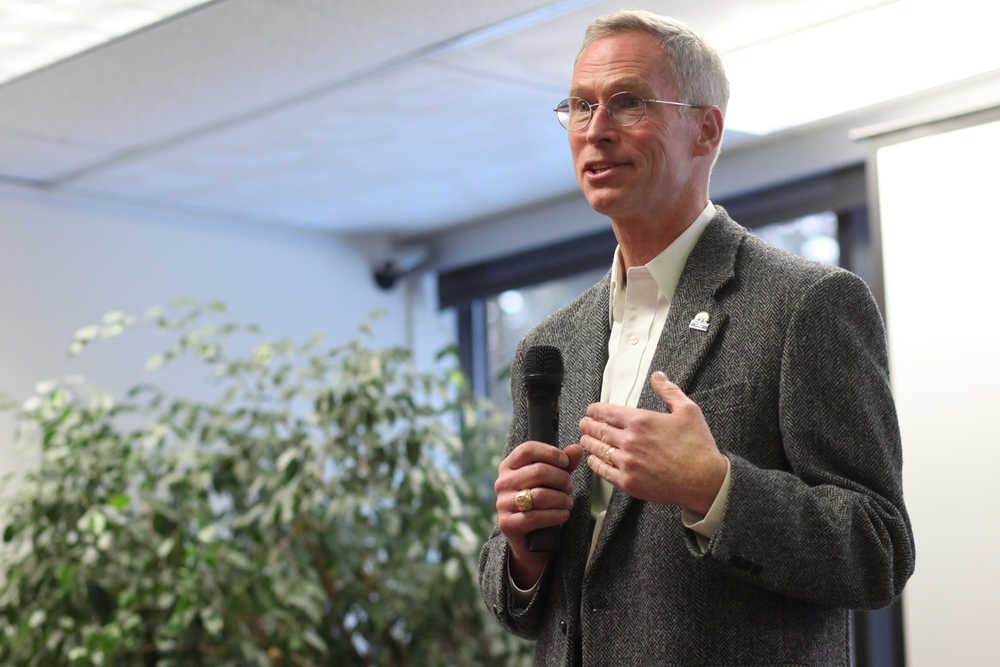Recently appointed University of Alaska President Jim Johnsen spoke words of optimism during his first visit to the Kenai Peninsula despite taking over leadership of a system facing financial challenges.
Johnsen touted the importance of investing in higher education during the first day two-day tour that began Tuesday with the peninsula’s first appointed Board of Regents member Lisa Parker.
“You can’t depend solely on the state to fund higher education,” Johnsen said. “…We are looking at everything, everything is on the table.”
Johnsen described the balancing act the UA system is facing in maintaining existing services, improving education for students and dealing with a third year of spending reductions. In dollars, that means the university has to find roughly $57 million in funding to make that all happen next year, he said.
Within his first 65 days on the job, Johnsen helped pass a $960 million FY17 budget that includes a request for the state to increase funding by 7.6 percent from the FY16 budget. He said he stands by the decision to support what he calls a “modest increase.”
“We will be able to make our case,” Johnsen said. “We are critical to our state’s future.”
The university plays a critical role in the viability of Alaska’s economy, as a major producer of the future workforce, Johnsen said.
Kenai Peninsula College freshmen Georgette Morgan said she attended the president’s talk at the campus because she wanted to meet him. She said she hadn’t previously been aware of the state’s fiscal crisis, or the effect it has had and will have on the university.
“It is kind of concerning,” Morgan said. “I like the medical field, I am really interested in it, and I am hoping that they don’t take it out.”
The regents and university administration are preparing to make cuts if the requested money from the state is not made available, Johnsen said. Programs may be consolidated or eliminated depending on location and enrollment, and other “various contingencies” are being put in place, including the importance of establishing stronger community partnerships, he said.
Johnsen said an example of the strategy would be if Kenai Peninsula College Director Gary Turner came to him and requested funding for a new residence hall. It would be unlikely the state would fund the project, but funding could potentially come from private investors, whom the college would pay back with revenue raised by housing fees, he said.
The Kenai Peninsula is unique in that the community has already shouldered some responsibility for providing the services and resources to students attending classes at the local campuses, Johnsen said. The Kenai Peninsula Borough Assembly chose to fund KPC with nearly $727,000 this year alone, most of which goes directly to the community college’s JumpStart program, he said.
JumpStart is only one of many offerings high school students have in higher eduction through the university, Johnsen said. He drove the point home before an audience of nearly 250 at Kenai Central High School Tuesday.
Johnsen also cited the US News and World Report’s 2015 school rankings. The list’s top schools graduate 91 percent of students within four years, while the University of Alaska Anchorage graduates 28 percent within six years.
Turner said it is the first time a UA president has made it to the peninsula in about seven years. He said it is imperative for the president to make the connections between the services he is in the care of and the people who are utilizing them.
KRC Student Union President Jayce Roberston said Johnsen seems to be genuinely invested in the success of the university’s population.
“I have been encouraged every time I have been around him,” Roberston said. “He seems to be focused and constantly driven and constantly thinking of the students.”
Reach Kelly Sullivan at kelly.sullivan@peninsulaclarion.com.

